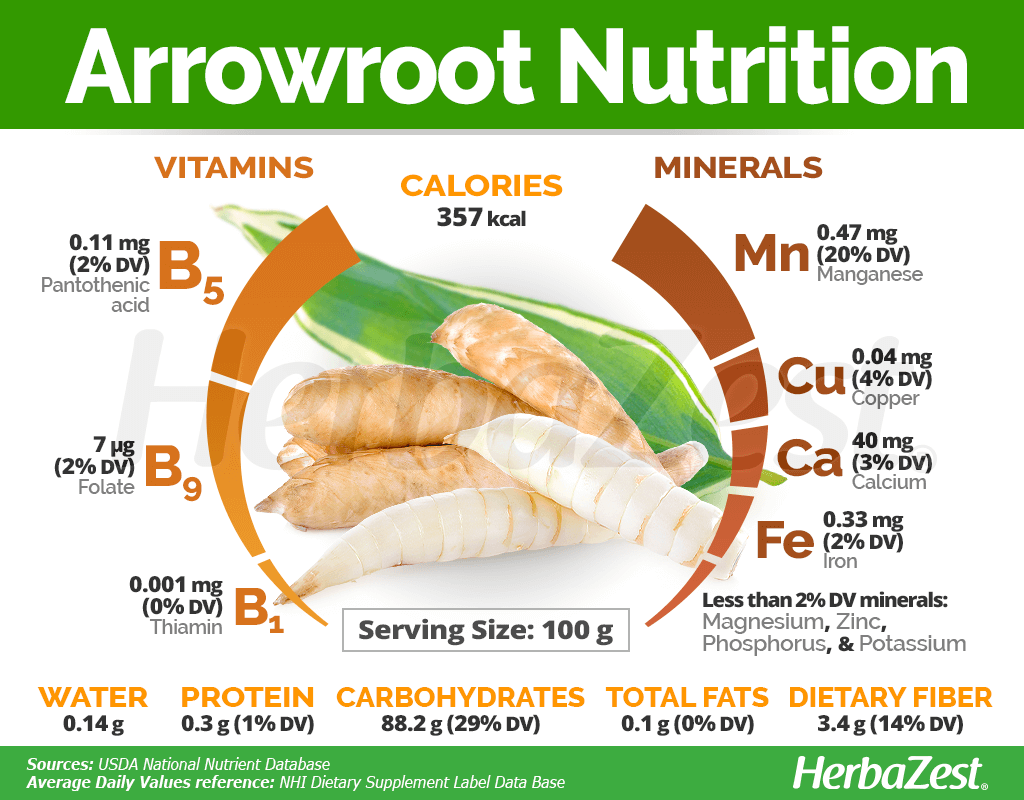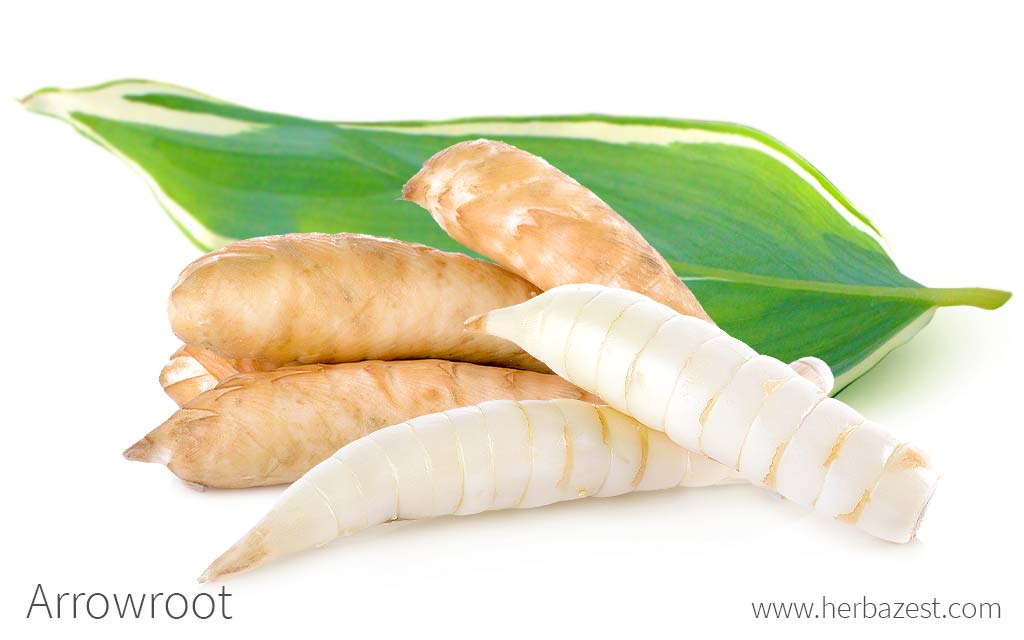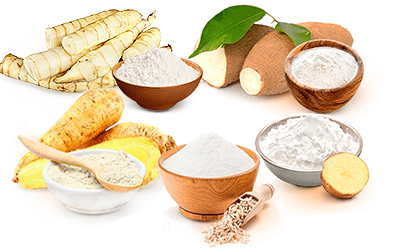Arrowroot is believed to have originated in South America, Mexico, and the Caribbean Islands, where it has been traditionally used by indigenous people for a wide variety of purposes. Today, arrowroot is mostly employed for cooking; however, some herbalists still recommend it for treating specific conditions.
Arrowroot Medicinal Properties
- Medicinal action Anti-inflammatory, Digestive
- Key constituents Carbohydrates (oligosaccharides and polysaccharides)
- Ways to use Capsules, Hot infusions/tisanes, Tincture, Poultice
- Medicinal rating (2) Minorly useful plant
- Safety ranking Safe
Health Benefits of Arrowroot
Arrowroot has been used for a variety of medicinal applications; however, today it is most often valued as a thickening agent in food, particularly because it is gluten free. Having said that, it is still possible to buy various arrowroot preparations that are designed for relieving certain ailments. Arrowroot's benefits have found a variety of medicinal uses, mainly:
Soothing digestive distress. Arrowroot is sometimes prescribed to those suffering from nausea, bloating, diarrhea, and other digestive complaints.
Supporting the digestive system. Recent studies suggest that arrowroot contains prebiotic fibers that act as food for probiotics (the "good" bacteria and yeast in the gut).
Reducing inflammation. It is believed that arrowroot can be useful as a demulcent and can be consumed to treat internal inflammation, or applied topically to treat skin irritations.
How It Works
Most medicinal applications use the tuberous roots of the plant, rich in complex carbohydrates, known as oligosaccharides and polysaccharides, which support the digestive system by protecting the mucous membrane of the gastrointestinal tract.1
Research has also revealed that arrowroot supports the presence of healthy bacteria, specifically lactobacillus. In one experiment, arrowroot's carbohydrates were extracted and added to a probiotic yogurt. It was then refrigerated for a period of time, and tests were carried out which revealed that more bacteria survived in the altered yogurt, than in the yogurt which did not contain arrowroot.2,3 The mechanisms behind this activity are yet to be fully understood, but are most likely related to the prebiotic fibers that arrowroot contains.
Arrowroot's properties comes from a few chemical compounds, and this tuberous root is known to be easily digested. For this reason, it is often suggested for babies who are just starting to eat solid foods, the elderly, who may have some digestive difficulties, and to anyone suffering from nausea or other gastrointestinal complaints.
Similar herbs with digestive and anti-inflammatory properties are arracacha, mashua, sweet potato, and amaranth.
Arrowroot Side Effects
Due to the simplicity of components within arrowroot, it is largely considered safe for ingestion or topical use. However, over-consumption of the plant may cause bloating or constipation, particularly if it is not administered as part of a varied diet.
Arrowroot Cautions
Although there are no known arrowroot-related side effects, women who are pregnant or breastfeeding, as well as those who are taking medication for any serious conditions, should always consult their doctor before taking any health supplement on a regular basis.
Arrowroot Nutrition
Arrowroot's nutritional profile is not particularly impressive, but it provides key elements for a healthy diet. Arrowroot is rich in carbohydrates, including fiber, which promotes gut health and intestinal regularity.
Additionally, arrowroot is a good source of manganese, a trace mineral that plays a key role in the formation of connective tissue and bones, as well as blood clotting and hormonal balance.
Other nutrients present in small amounts in arrowroot are calcium, iron, copper, vitamin B5 (pantothenic acid), and folate.
100 grams of arrowroot flour provide 357 calories, 29% DV of carbohydrates, and 14% DV of dietary fiber.

How to Consume Arrowroot
- Edible parts Root
- Edible uses Curdling agent
- Taste Earthy
Throughout the ages arrowroot has been available in a range of different preparations. Although today, it is most often seen as a culinary ingredient, herbalists still recommend it in medicinal preparations.
Some arrowroot products - such as biscuits - are also sometimes suggested to sufferers of nausea and vomiting, when they are hungry but still have a sensitive stomach.
Today, arrowroot is most valued for its role as a thickening agent in foods - particularly because it is a gluten free option. The powdered root can be stirred into water and added to sauces, gravies, curries, and other liquid foods. It is generally recommended to use 2.5 teaspoons of arrowroot powder per cup of liquid.
Another relatively well-known food is arrowroot biscuits. These are marketed in the U.S., the U.K., Europe, and Australia, and are recommended as an option for young children who are first starting to eat solid foods, especially when they are teething, since it is thought that arrowroot may also help alleviate gum irritation.
Natural Forms
Infusion. The dried root is ground into a fine powder and added to hot water on its own or with other ingredients such as ginger, honey, or lemon for taste. It is particularly recommended for soothing stomach complaints.
Poultice. Arrowroot poultices have been traditionally used in the Caribbean and South America to treat smallpox sores, gangrene, and bites from scorpions and spiders.
Flour. Arrowroot powder or flour is a popular thickener, particularly appreciated in gluten-free diets, with the added value of its prebiotic and anti-inflammatory effects.
Herbal Remedies & Supplements
Tincture. Dried root powder can be combined with a solution of 40% alcohol to make a tincture, which should be diluted with water, juice, or tea for drinking. This is recommended for treating internal inflammations.
Capsules. Arrowroot powder can also be consumed in this supplemental form, which is sometimes prescribed for relieving nausea and diarrhea.

Growing
- Life cycle Biennial
- Harvested parts Rhizome
- Light requirements Partial shade
- Soil Medium (loam), Well-drained
- Soil pH 6.1 – 6.5 (Slightly acidic)
- Growing habitat Tropical regions
- Plant spacing average 0.9 m (2.95 ft)
- Growing time 10 - 12 months
- Propagation techniques Divisions
- Potential insect pests Caterpillars
- Potential diseases Root rot, Botrytis leaf blight
Native to the tropical Americas, the arrowroot plant is not commonly cultivated on a large scale around the world. However, if certain conditions are met, this ornamental and useful plant can be successfully grown in a home garden or a backyard.
Growing Guidelines
Arrowroot can be propagated from seeds or root divisions and requires a temperature range of 73 - 84°F (23 - 29°C) in order to thrive.
The arrowroot plant needs a slightly acidic, well-drained, and loam soils, as well as frequent watering so it can properly develop its tuberous roots.
Arrowroot is meant to be grown outdoors, with natural sunlight, although it needs partial shade. However, the plants can be started indoors before being transplanted to the garden.
High humidity and warm temperatures are necessary for arrowroot to grow healthy.
The longer arrowroot is left to grow, the larger the tubes will be. At least 10 months of growth are required before arrowroot roots are ready to be harvested.
Arrowroot plants are fairly resistant to infestations; however, in the tropics where they are grown on a large scale, caterpillars can be a problem.
Occasionally, the arrowroot plant can be affected by root rot and leaf blight.
Detailed information about growing arrowroot can be found in the herb garden section.
Additional Information
- Other uses Animal feed, Paper, Fuel
Plant Biology
There are actually several plants with tuberous roots which are frequently referred to as 'arrowroot;' however, the true species is scientifically known as Maranta arundinacea. It is a perennial which takes almost one year to completely develop. The underground roots - or rhizomes - are the part of the plant that is traditionally used by humans. From the tubers, thick erect stems develop, and large pointed leaves grow from these. The aerial portion of the plant can reach heights of 2.5 feet (76 cm), and the root can become around one foot (30 cm) long.
Classification
Maranta is one of 28 genera belonging to the Marantaceae botanical group, also known as the prayer-plant family due to the fact that many of these species have their leaves folded together, like hands in prayer. There are 569 accepted species within this group, 42 of which are under the Maranta genus.
Related Species of Arrowroot
M. arundacea is the only member of the genus whose edible root has economic value. A lesser known Maranta species, M. varicata, is consumed by Paraguayan natives as an emergency food. Most Maranta species are grown as ornamental plants, mainly the Brazilian M. leuconera, from which at least four cultivars have been created.
Other species that are commonly referred to as arrowroot but botanically unrelated are Queensland Arrowroot (Canna edulis), East Indian arrowroot (Curcuma augustifolia), Tahiti arrowroot (Tacca oceanica), tapioca (Manihot esculenta), and Portland arrowroot (Arum maculatum), all of them have similar uses to M. arundinacea, as they are also sources of starch.
Historical Information
The English name 'arrowroot' is believed to have been derived from a misspelling of the Caribbean word ara-ruta, which means mealy root.
Arrowroot was introduced in the United States via the West Indies, in the 18th century. It first appeared in Georgia around 1800, when it was first cultivated by two farmers, Campbell Wylly and John Cooper. It became increasingly popular, particularly among religious groups who advocated strict dietary rules.
Economic Data
Large scale production of arrowroot for industrial purposes began in the middle of the 19th Century in the Caribbean islands of Antigua and St. Vincent, with St. Vincent as the principal producer for the United States, Canada, and Europe. The island produced about 4500 tons annually after the Second World War, but it now commercializes only up to 3000 tons of the starchy root. The demand for arrowroot starch is limited by its high price compared to other starches and the fact that its processing methods require large quantities of water.
Outside the Caribbean, cultivation has spread to many other tropical countries, including Brazil, India, Sri Lanka, Indonesia, and the Philippines. However, arrowroot products are mainly traded locally on a very small scale. Statistics on imports are mixed with other plant sources of starch - such as cassava.
Popular Beliefs
There is a myth surrounding the etymology of the name arrowroot. Many people believe it is attributed to the shape of the tubers. It has also been claimed that it comes from a traditional use of the plant as a poultice for wounds caused by poisoned arrows. However, there is little evidence to suggest that the latter is true.
Other Uses
Paper. The fibrous texture of the root is fairly tough, which makes it suitable for making a tear-resistant type of paper. Arrowroot starch is used in the manufacturing of carbon-less paper for computers.
Fuel. Arrowroot has also shown to be a promising source of fuel since it can be transformed into 56% pure ethanol.
Fodder. The shoot tips and leaves of arrowroot are locally employed as a fodder for farm animals, such as pigs and chickens.
Fertilizer. Industrial residues of arrowroot can also be used as compost and mulch.
In the Philippines, the root of the arrowroot plant is traditionally used for starching clothes.
Sources
- American Heritage Vegetables, Arrow Root
- Edible Medicinal And Non-Medicinal Plants, pp. 47 – 53
- The Plant List, Maranta
- Top 100 Exotic Food Plants, pp. 51 – 54
- University of Florida, IFAS Extension, Arrowroot - Maranta arundinacea
- World Vegetables: Principles, Production, and Nutritive Values
Footnotes:
- Cytotechnology.(2012). Evaluation of immunostimulatory effect of the arrowroot (Maranta arundinacea. L) in vitro and in vivo. Retrieved November 25, 2022 from:https://www.ncbi.nlm.nih.gov/pmc/articles/PMC3279578/#CR15
- International Journal of Scientific and Research Publications. (2012). The Effect of Arrowroot (Maranta arundinacea) Extract on the Survival of Probiotic Bacteria in Set Yoghurt. Retrieved November 25, 2022 from: https://www.semanticscholar.org/paper/The-Effect-of-Arrowroot-(-Maranta-arundinacea-)-on-Abesinghe-Vidanarachchi/becee2fd5ffb8ac0fc04ab177a90483d4f5b0d88
- International Research Journal of Microbiology. (2011). Effect of arrowroot (Maranta arundinacea L.) diet on the selected bacterial population and chemical properties of caecal digesta of Sprague Dawley rats. Retrieved November 25, 2022 from: https://www.interesjournals.org/abstract/effect-of-arrowroot-maranta-arundinacea-l-diet-on-theselected-bacterial-population-and-chemical-propertiesof-caecal-dige-17262.html







